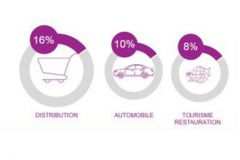In 2024, net advertising revenues reached 18.9 billion euros, recording growth of 7.7% compared to 2023, according to the Unified Advertising Market Barometer (Bump), derived from cross-referenced data from Irep, Kantar and France Pub. The Euro soccer tournament and the Paris Olympic Games have led to a significant influx of advertising spend, particularly on digital channels and outdoor advertising. However, this growth is not benefiting all segments equally, and print advertising is suffering as a result.
Digital continues to gain momentum
With an increase of 14%, digital has established itself as the market's key lever. Video (+32.4%) and audio (+22.7%) formats captured advertisers' attention, while DOOH (digital out-of-home) posted record growth of 16.1%. Programmatic advertising and retail media are helping to restructure the advertising landscape, increasingly relegating print media to specific uses.
Advertising printing and billposting: contrasting trends
The outdoor advertising market was buoyant, up 7.6%, thanks in particular to DOOH and the boom in digital street furniture. On the other hand, the print media suffered a 5% decline, affected by a drop in advertiser investment.
Directories, once a key medium for local businesses, continue their collapse with a 4.1% drop in 2024 and a 36.4% decline on 2019.
Similarly, unaddressed printed matter is down 10.8% on 2023, and 39.3% in five years. Digital leaflets, meanwhile, are up 35.6%.
Direct print marketing, although under pressure in the face of more targeted digital alternatives, maintains a certain stability with investments of 4.85 billion euros in 2024, down 4.4% on 2023 and 32.6% on 2019.
Investment in Promotions & POS (point-of-sale advertising) continues to be affected by budget cuts, with a 2.5% decline in 2024.
In contrast, event advertising saw a notable increase of +17.6% on 2023 and +13% on 2019, driven by the Olympic Games and Euro 2024.
Luxury and printing: a changing relationship
The luxury goods sector, historically a major user of print media for its campaigns, saw limited growth of +3% in 2024, a far cry from the increases seen in previous years. This stagnation is partly explained by a downturn in the last quarter (-6%).
Advertising spend in the luxury goods sector remains concentrated on the printed press and outdoor advertising, which remain strategic media despite an overall decline of -5% for the press.
However, strategies vary from group to group: LVMH posted a slight increase of +2%, while Chanel fell back by -6% and L'Oréal and Richemont each recorded a decline of -12%. On the other hand, Hermès (+32%), Kering (+21%) and Giorgio Armani (+15%) show a much more favorable dynamic.
Outlook 2025: an uncertain future for print advertising
Bump's projections for 2025 point to moderate growth in the communications market (+0.5%), reaching 35.9 billion euros, with a decline in the five traditional media (press, outdoor advertising, television, radio and cinema) and a continued rise in digital (+8.2%).
Other media, notably print advertising and direct marketing, would continue their downward trend, with a -3.7% decrease, due to an unfavorable base effect after the peak in investments linked to the 2024 Olympic Games








